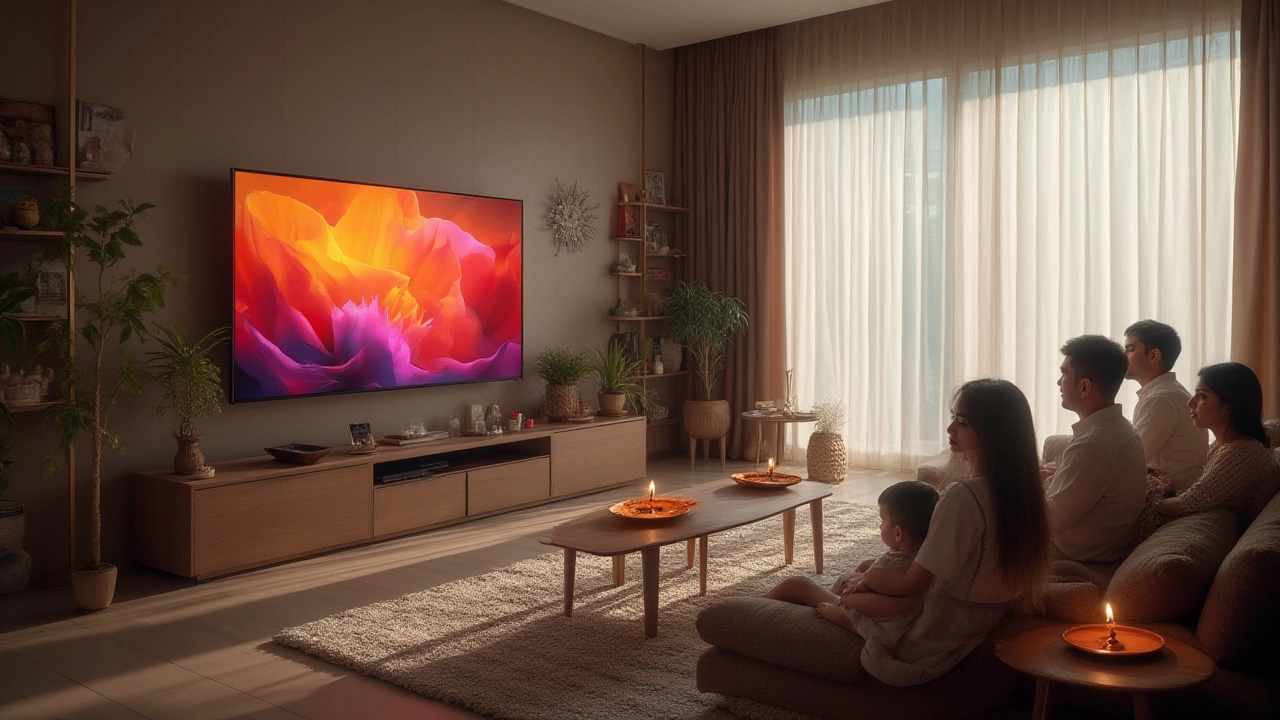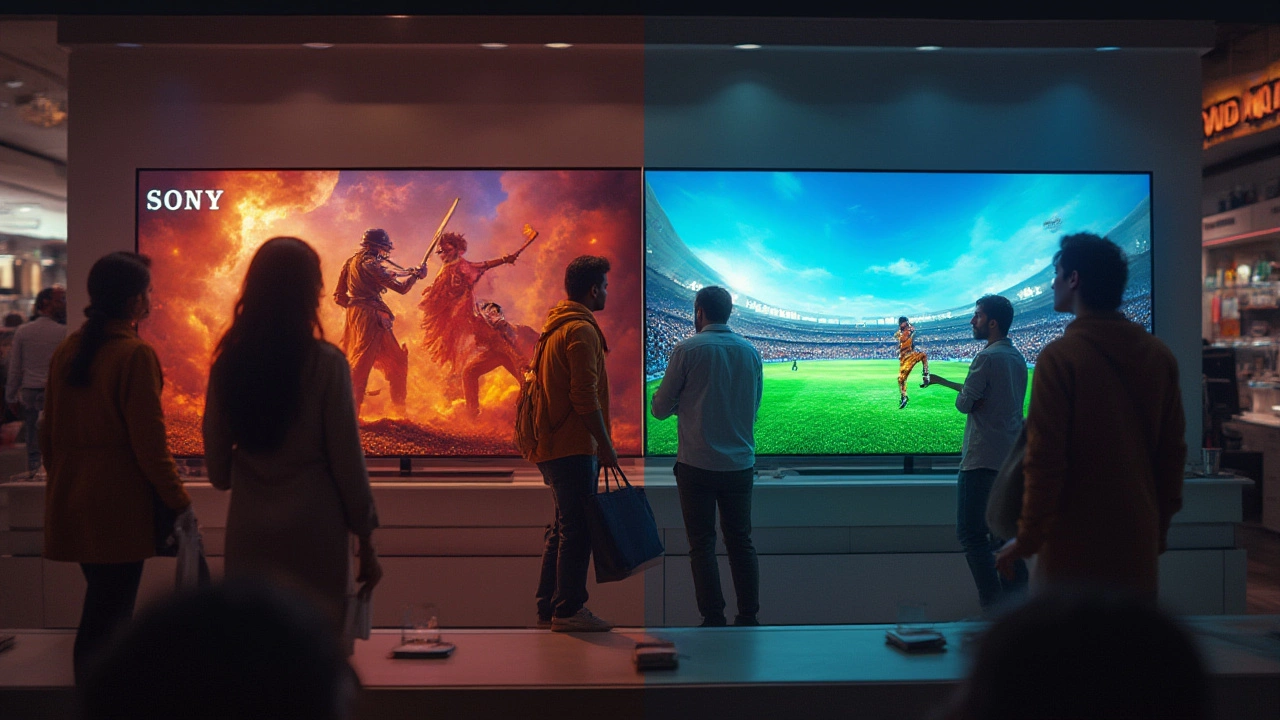
Imagine standing in the electronics aisle, surrounded by a sea of glowing screens. Sony on one side, Samsung on the other. Both of them have stunning displays, slick designs, and prices that range from 'bargain' to 'I-hope-this-lasts-a-decade.' If you feel overwhelmed by all the specs, buzzwords, and online debates, welcome to the club. Even my cat Luna can't decide which screen to nap in front of, and Max just likes the remote. But here's the thing—behind every sleek logo, these two brands do things differently, and those differences might matter more than you think.
Sony vs Samsung: The Showdown of TV Technology
If you're hoping for a clear winner, things get complicated fast. Sony and Samsung go head-to-head in almost every category, but they each champion different technologies. Samsung leads the charge with QLED, which stands for Quantum-Dot Light Emitting Diode. It's catchy, but here's what it really means: QLED TVs use a layer of quantum dots in front of an LED backlight to boost brightness and color. If you love watching stuff in a sunny room or crave those jaw-dropping HDR highlights, Samsung might already have your attention. Some recent tests show new Samsung QLEDs reaching up to 2,000 nits of peak brightness, which looks amazing during action scenes or sports in daylight.
Meanwhile, Sony is famous for mastering OLED panels—think deep blacks, infinite contrast, and lush colors that make movies feel like magic. Because OLED displays light up each pixel individually (no backlight), their black levels are unbeatable. That, combined with Sony’s ace processing—hello, Cognitive Processor XR—gives you the kind of detail in shadows and highlights that even picky film fans respect. For pure picture quality, a Sony OLED like the A95L regularly gets top marks from independent reviewers. But that's not the whole story...
The real twist? Samsung jumped into the OLED game too, with its S95C and S90C series using the fancy Quantum Dot OLED panels. Now you have Samsung and Sony both making OLEDs that cost about the same. Who does it best? In side-by-side demos, Sony’s color processing still edges out Samsung by a hair; reds and skin tones look just a bit more true-to-life. Samsung, though, serves up a brighter, punchier panel—especially handy in sunlit rooms.
Let’s drop a quick comparison:
| Feature | Sony (A95L OLED) | Samsung (S95C QD-OLED) |
|---|---|---|
| Peak Brightness | 1,400 nits | 1,600 nits |
| Black Levels | Perfect | Perfect |
| Color Accuracy | Outstanding | Excellent |
| Motion Handling | Excellent | Very good |
| Operating System | Google TV | Tizen |
But wait—both companies also make more affordable LED-LCD models. Here, Samsung's mid-range Crystal UHD and Sony's X80K or X90L models are fierce competitors. Samsung often pushes for bolder, saturated colors and brighter images. Sony leans into fine-tuned accuracy and better upscaling, making even older shows look crisp. That all might sound technical, but if you mostly watch HD cable or YouTube, Sony's smoother upscaling is something you’ll actually notice.
Smart TV Platforms: Which Interface Actually Works for Humans?
You'd think a TV's “brains” shouldn’t matter, but in 2025, it totally does. The remote isn't just for changing channels—it's your gateway to Netflix, YouTube, gaming, sports highlights, smart home controls, and more. Samsung’s smart platform is called Tizen. It’s polished, fast, and custom-built for Samsung TVs. People love its fluid app support and quick loading times. The customizable home screen lets you pin your go-to apps, and the settings are deep but not overwhelming. Plus, Samsung still supports every streaming service you can think of—including some niche ones for indie films or geeky sports leagues.
Sony now relies on Google TV, which builds on Android TV but in a way that feels slicker and less clunky. If you’re tied into Google services—maybe you use YouTube Music, Chromecast, or Google Photos—you’ll notice the benefits. Voice controls, powered by Google Assistant, are reliable and surprisingly handy for things like asking for the weather, turning off smart lights, or searching for action comedies with Tom Cruise. Yeah, you can even put Google Calendar reminders on your TV if you want. The app library is a bit bigger than Samsung's, especially for international users or those with oddball subscription services. Sony’s voice interface is probably a win for folks who like things hands-free.
But here’s a curveball: both brands support Apple AirPlay 2 for screen sharing. If you’re in the Apple ecosystem, you won’t feel left out. Sony even adds Apple HomeKit compatibility. Yet, Samsung has a clever “SmartThings” dashboard to control your smart home gadgets all from the TV. They also offer Samsung TV Plus—a bunch of free, ad-supported live channels if you like to channel surf without a cable box.
Speed? Both Tizen and Google TV are quick on the latest hardware. But some older Sony models from 2022 and before suffered from laggy menus, while Samsung tends to keep things snappy even on their more affordable sets. If you hate waiting for a menu to load, you might lean Samsung. Still, Sony’s voice search and recommendations engine is more “watch this next” and less “buy this now,” which feels a bit more personal.
Remote controls are another battleground. Samsung’s solar-charged remote (no batteries needed!) is a neat trick—especially if you hate chasing AAAs. Sony’s remotes are more traditional, but now come with backlighting and a lost-remote finder if you have buttery fingers like me. There are pros and cons on either side, but it's fair to say Samsung’s interface is tuned for simplicity and speed, while Sony’s Google TV is all about flexibility and recommendations tailored to your tastes.

Sound, Design, and Gaming: The Real-World Experience
Picture is king, but you won’t love your new TV if every explosion sounds like a cheap thud. Sony knows this and tends to put real effort into audio. Their “Acoustic Surface Audio+” tech (on higher-end OLEDs) literally turns the screen into a speaker, so dialogue seems like it's actually coming from the actors’ mouths—not just a tinny speaker underneath. It’s a trick that really works if you care about movies or hate setting up a separate soundbar. Even on Sony’s cheaper models, sound quality is about a notch above the usual. Is it a replacement for a full sound system? Not really—Max still jumps when I turn on the subwoofer—but it makes casual watching way better.
Samsung’s sound isn’t wimpy, but most of their TVs rely on traditional downward-firing speakers. They're fine for news, sports, or reruns, but action movies or bass-heavy scenes can reveal their limitations. Where Samsung scores is by tightly integrating their TVs with Samsung soundbars using “Q-Symphony.” If you go all-in on Samsung gear, your TV and soundbar work together as a single system, filling your living room with surprisingly immersive sound. The thing is, this combo works best if you actually pony up for a Samsung soundbar—not always cheap, but worth it for the home theater crowd.
Design-wise, both Sony and Samsung have raised their game. Samsung goes ultra-slim with the “Infinity One” design for its flagships—it seriously looks like a sheet of glass floating in your living room. Mount it on the wall, and it nearly disappears. Samsung also wins on cable management; their “One Connect Box” keeps messy wires out of sight—my cat Luna definitely approves. Sony models aren’t ugly by any stretch, but most have chunkier frames and stands. If your TV is the centerpiece of your living room, Samsung’s minimalist vibe is hard to beat. That said, Sony’s more classic stands are sturdy and often leave room for a soundbar or gaming console underneath.
Love gaming? Both brands have invested big in making their 2025 TVs ready for PlayStation 5, Xbox Series X, or gaming PCs. Samsung leads with ultra-fast HDMI 2.1 ports on nearly all new models, variable refresh rates (VRR), and ALLM (Auto Low Latency Mode). Gamers rave about Samsung’s Game Bar—an overlay that shows frame rates, HDR status, and lets you tune settings on the fly. Input lag is stunningly low. Sony has caught up, and their latest OLEDs and high-end LEDs also boast fast HDMI 2.1, VRR, and ALLM. But, oddly, only two HDMI ports on most Sony sets support full 4K120Hz, so if you have a PS5, Xbox, and gaming PC all plugged in, you’ll be switching cables. Sony does offer exclusive PS5 features like Auto HDR Tone Mapping, which makes PlayStation graphics look their best, but the advantage is small. If gaming is your world and you want plug-and-play simplicity, Samsung’s gaming features are just a bit more mature. Still, for pure image quality, Sony's OLED is what you want for those moody, beautiful games.
Price, Support, and Which TV Makes the Most Sense for You?
Let’s be real—your budget is probably the tiebreaker. Sony and Samsung price things differently, but both have premium models that creep well over $2,000 if you want a big stage. Samsung used to be the king of budget, but lately their best QLEDs and QD-OLEDs have shot up in price—at launch, the Samsung S95C 65-inch started around $2,500, while the comparable Sony A95L hovered closer to $3,000 (street prices move all the time, so check before you buy). Move down the ladder, and Samsung’s Crystal UHD series gets you a solid 4K set for under $600. Sony’s X80K or X77L lines start around $700 but often include more accurate out-of-box color and better upscaling for less polished sources.
Support and after-sales? Samsung has a robust ecosystem, so if you buy a Samsung phone, soundbar, TV, and even fridge, everything talks to each other. Their customer support is fast and solutions-focused; warranty repairs are often straightforward, at least in the US and Europe. Sony’s support can be slow, but their TVs are famously reliable. It’s not weird to see a 2014 Sony Bravia still running strong in someone’s living room. Both brands get regular firmware updates; Samsung pushes flashy interface overhauls, while Sony quietly boosts picture quality or fixes bugs. For tinkerers, Sony allows more user calibration features in their settings, while Samsung has a more “locked down” interface to keep things simple.
Energy use deserves a quick note. New Samsung TVs, especially their Neo QLEDs with Mini LED backlights, are surprisingly efficient—useful if your screen is on all day. Sony’s OLEDs draw more power for large panels, especially at max brightness. Neither will bankrupt you on electricity, but it’s a detail to note if you’re picky about eco-friendliness.
The last wild card: showroom demos can be misleading. Both brands pump up store settings to max jaw-drop mode, but those settings look garish at home. Always reset new TVs to “movie mode” or “filmmaker mode” on day one—trust me, your eyes will thank you. Both Sony and Samsung back up their flagship TVs with industry awards from sites like RTINGS and AVForums, but the real-world gap between the best from either brand is small. The trick is weighing what you care about: peak brightness (Samsung), flawless blacks and color accuracy (Sony), interface speed (Samsung), hands-free Google smarts (Sony), slick design (Samsung), or immersive built-in audio (Sony).
So, who makes better TVs—Sony or Samsung? The Best TV brands crown honestly goes to whichever one nails your most important needs. My own take? Movie lovers who crave every detail and realistic color often wind up happiest with Sony. If your place is full of sunlight, you binge sports, or you’re gaming into the night, Samsung’s loud, bright panels and fast, flexible interface are tough to top. Either way, you’re not making a bad call; just make the right one for how you actually live, not just what the ads say. Besides, whichever you buy, you might still catch Max stretched across the remote and Luna eyeing the bird documentary—guess some viewers are happy with any great TV after all.